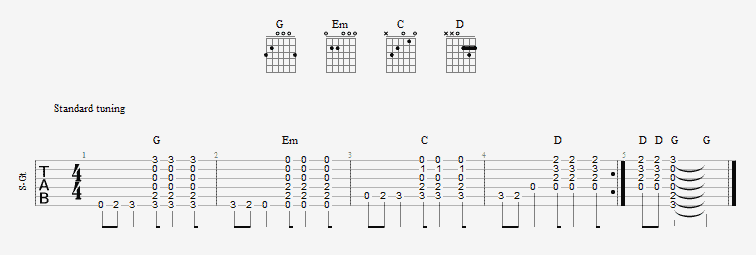Walking up or down into a chord is a really nice way of making a transition from one chord to another. The technique is also called a walking bass line.
It is used in country, bluegrass, and jazz very often, but you can use it in other genres as well. At the most basic level, you can use it to add a bit of extra something to your chord progression and to liven your strumming patterns.
When we walk into a chord, we'll always be playing a baseline, so we'll be plucking the lower strings of the guitar. This can, of course, mean the low E string, the A string, or even the D string at times, depending on which chords we're working with.
Let's have a simple example to demonstrate walking between chords on the guitar. Here are the tabs and the audio clip of a simple chord progression with a walking bassline. Note that this is a I-vi-IV-V chord progression in the key of G in 4/4 time:
As I mentioned, we basically plucked a few notes of the key we're in, to lead into the next chord. But which notes do we need to pluck and why? Let's have a look at the details:
- Start out straight away by "walking up" into the G chord for 2 beats, by plucking two 8th notes and then a quarter note to give it a swingly feel. The actual walk is the two 8th notes, the 3rd pluck is already the chord tone we were aiming for, but we don't strum at first.
- Now do a 2 beat strumming pattern on G major, strumming DU U
- Walk down to the E minor, keeping the swing feel, plucking G, F# and E
- Do the same DU U strumming pattern on Em.
- Now walk up to C major by plucking A, B then C, followed by the DU U strumming pattern on C major
- Next we finish our progression with the V chord, the D major. We can't walk up from the base note of the C major, since that is a C, and the next diatonic note in the G major scale is already a D, so we'll walk down a note then up to the D. So using the same swing rhythm, on the A string pluck the C then B, next move up to the D string and pluck the open D. Now you can strum the DU U pattern on the D major.
- And since this is a chord progression, you can either start it over, or end with a strum of the G major.
The rules of walking bass lines
So here is what you need to keep in mind when playing the above, and with walk-ups (or walk-downs) in general:
- Mind the rhythm, notice that even during the single note plucks, your hand is moving as if you had a continuous strumming pattern, never halting. The rhythm of a walking bass is constant.
- The single notes you pluck will be from the key you're playing in, so we'll be moving diatonically (which means within the scale). So in our example, we're in the key of G major, so all of the single notes we pluck are on the G major scale. Many people think that they need to pluck notes from the chord they are walking into, which is not the case, and would make things harder anyway. You just need to use the scale of your key.
- You can't repeat notes during a walk. Why? Well, because then you wouldn't be walking now would you 🙂
There you have it, walking bass lines 101. Feel free to experiment with the technique, and make use of it in your own playing as you can.


do you have a tabulator chart of the walks into more chords?